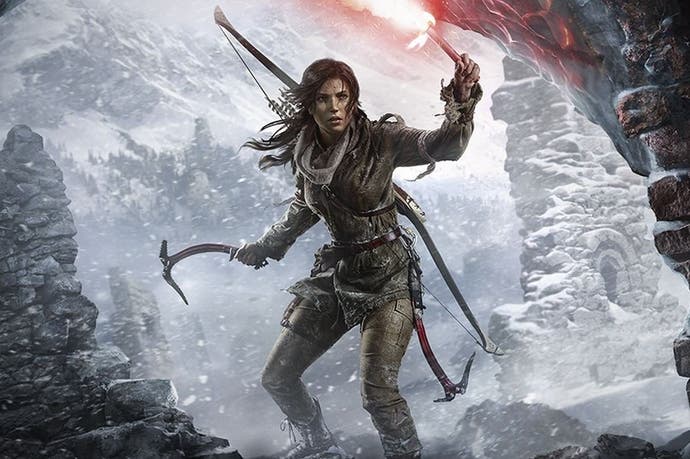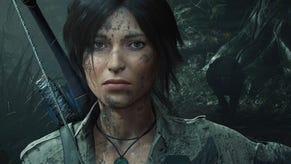Tech Analysis: Rise of the Tomb Raider
Digital Foundry on what works and what doesn't in November's big Xbox exclusive.
This morning we're publishing our Face-Off for Rise of the Tomb Raider, where we compare the Xbox One version to the quite remarkable Xbox 360 game. Bearing in mind how important the new technological features are to the Xbox One release, we thought we would re-publish our full tech analysis alongside today's comparison.
Rise of the Tomb Raider arrives on Xbox One this week just one year shy of the series' 20th anniversary. It's a franchise with a tumultuous past, but with the 2013 reboot, Crystal Dynamics managed to bring the franchise back into the spotlight in a big way. However, throughout its long history, nearly every one of Lara Croft's adventures could be found on a PlayStation platform. It was never exclusive, but millions of gamers came to associate Croft and friends with Sony's platforms - so when Microsoft announced timed exclusivity for Rise of the Tomb Raider last year, the reactions weren't entirely positive, to put it lightly.
However, from the developer's perspective, focusing on a single platform enables a more concentrated development cycle that should, theoretically, lead to a more polished game. With Crystal focused entirely on Xbox One, Rise of the Tomb Raider suddenly becomes a project competing with other first and second party developers and the need to polish up multiple versions of the game is postponed, for the time being at least. So, the key questions remaining are simple: does Rise of the Tomb Raider deliver the kind of experience typically reserved for first party releases, and has the decision to also release the game on Xbox 360 impacted the end results on Xbox One?
At its core, Rise of the Tomb Raider is built on the in-house Foundation Engine that Crystal Dynamics has been iterating on for years now. The tech has delivered excellent results across multiple generations of consoles and in bringing this engine to Xbox One, we are treated to a whole host of new features. This includes a physically-based materials system, image-based lighting, deformable snow, improved hair simulation and more. It's a beautifully crafted game with a rich level of detail packed into every scene, but it doesn't always come together as tightly as we had hoped.
The approach to visual design in Rise of the Tomb Raider is interesting in that the majority of changes and improvements made to the engine are focused primarily on the refinement of the presentation. They add to the experience by delivering a higher fidelity, but it's clear that the game plays out in a fashion very similar to the previous game. This is an evolution of Tomb Raider but one with that looks better than any game in the franchise before it.
With these new rendering techniques in play, has Crystal Dynamics managed to take advantage of the strengths of the platform and really deliver something that really pushes the visual envelope? At what cost do these new features come and how does it impact the experience? Let's begin by taking a closer look at the numerous features that take advantage of the Xbox One to produce something that feels suitably 'next-gen'.
What works
- TressFX: Rise of the Tomb Raider introduces the latest generation of TressFX and it looks excellent in motion. TressFX is a spline-based hair rendering solution featuring thousands of individual hair strands. These strands are controlled by master strands which then help determine the behaviour of the hair in different situations. This means that hair can blow violently in the wind, float gently in a pool of water, or droop realistically when wet. The implementation in this new game manages to minimise the sometimes glitchy behaviour we encountered in the last game.
- Character rendering: Aside from the beautifully rendered hair, character models also feature very realistic skin shading and rendering along with realistic clothing materials. Faces employ full sub-surface scattering complete with backscattering enabling more realistic portrayal of light across the skin. This is most evident during the beautifully realised real-time cut-scenes, but makes a clear impact in-game as well.
- Material effects: Lara spends an inordinate amount of time slogging it through muddy creeks and snow covered mountains so it's only natural that Crystal Dynamics would implement a system to reflect these environments on their lead character. Lara's character model can show blood, water, snow, and dirt effects across both skin and clothing. These effects can be combined and adjusted on a per-effect basis enabling some very realistic layering. It brings an extra layer to the exploration aspect of the game by more directly tying Lara to the environment.
- Deformable snow: Rise of the Tomb Raider makes use of deformable snow in a number of locations. This has been achieved using a form of adaptive tessellation paired with normal and height maps. The grid from which the snow is constructed varies geometric density based on camera proximity enabling a smoother mesh during normal gameplay angles. The depth of the snow varies heavily throughout these areas and Lara's animation reacts naturally to the varying conditions. Unfortunately, deformable snow is not utilised in every snowy area. For instance, the mountainous region following the Soviet Installation, is covered in snow - but the majority of it lacks the effect completely. Still, when it works, it's perhaps the best implementation of deformable material we've seen yet.
- Pre-rendered effects: One of the more interesting techniques we see here in Rise of the Tomb Raider comes from the depiction of fluid dynamics in several key sequences. This is achieved using a unique blend of real-time visuals with pre-rendered effects. The avalanche that occurs early in the game or the water bursting from a temple in Syria use this effect very effectively. The effects are blended so seamlessly that it isn't entirely apparent that we're looking at something pre-rendered. The only real limitation centres on the fact that these effects cannot co-exist easily during sequences in which the player has control.
- Real-time cut-scenes: The cut-scene sequences present in Rise of the Tomb Raider offer some of the most impressive visuals in the game. The mix of natural motion, high quality post effects, and realistic materials really helps sell these sequences. Actors and actresses were captured using the Mova performance capture system which uses a paint system rather than the traditional pasted white balls to track expressions. This data is then fed into the engine which makes use of blendshapes rather than the traditional bone structures. Blendshapes work by breaking up key expressions into individual shapes which can be animated in various combinations enabling a very natural performance. The results are mighty impressive and created some of the most nuances cinematic sequences we've seen to date.
- Volumetric lighting: Rise of the Tomb Raider features a plethora of volumetric lights throughout. Using a resolution-agnostic voxel method similar to Killzone Shadow Fall, each light is generated using asynchronous compute late in the rendering order. We see these lights appear in a multitude of situations ranging from sun shafts to thick fog. In many cases, volumetric lighting is combined with screen-space light shafts to create some very dramatic scenes.
- Motion blur: High quality object motion blur is one of our favourite visual effects and Tomb Raider brings it in spades. The sample count is high and applied to objects and camera movement alike enabling some very fluid movement. This is a key feature which is missing in Tomb Raider 2013 that helps create a much more cinematic experience.
- Animation layering: Lara now features a much wider selection of animations and each can be combined to create nuanced, layered motion. The fluidity with which these animations are tied together creates a very consistent presentation throughout despite the number of actions the player can engage in.
- Procedural music: Utilising a middleware solution created by Intelligent Music Systems, Rise of the Tomb Raider features a fantastic selection of highly dynamic music throughout the game. Rather than simply cross-fading pre-recorded audio streams, the solution employed here is able to generate real-time audio that dynamically changes based on data created by the game's composer. When facing off against a pack of wolves, for instance, we were impressed with how layers of music would build up based on the proximity of the animals. From a distance, the music is slow and focused on light percussion, but the audio ramps up in a dramatic fashion as the wolf approaches for an attack. It's an incredibly impressive solution to the dynamic music situation that works beautifully throughout the game.
What doesn't
- Image Quality: - Rise of the Tomb Raider operates primarily at 1920x1080 with post-process anti-aliasing in effect. During cut-scenes this is knocked down to 1440x1080. Unfortunately, the anti-aliasing solution here combined with the assets in use simply cannot keep up with what is on display and we're left with noticeable sub-pixel breakup and shimmering throughout many sequences in the game. Furthermore, we noticed a recurring artefact in which pixels along certain edges appear much lower in resolution than the rest of the game. Just to give a better idea of how the lower resolution used in cut-scenes fares from a gameplay angle, we managed to capture a pair of shots showcasing just this. The first shot was taken just as the cut-scene returned control over to the player and is still rendering at 1440x1080. One frame later, the game returns to 1920x1080. Perhaps 1440x1080 with improved anti-aliasing could have yielded better results?
- Frame-rate: Rise of the Tomb Raider targets 30 frames per second with adaptive v-sync and reaches its objective fairly often. However, we ran across a significant number of scenes in which this frame-rate could not be maintained leaving us instead with judder and torn frames along the top 30 per cent of the image. We noticed a performance penalty when engaging enemies in combat as well though slowdown can occur even in sequences without any enemies or characters on screen.
- Input latency: One issue we struggled with throughout the game is its input latency. Prior to receiving the game, we spent some time revisiting Tomb Raider on both PlayStation 3 and PlayStation 4 and found that Rise of the Tomb Raider feels less responsive. Aiming is more cumbersome and difficult here to the point where it feels more as if you're pushing the camera rather than directly controlling it. It's not an issue during exploration or puzzle solving, but combat suffers.
- Materials: Rise of the Tomb Raider has made the jump to a physically-based renderer but the results leave something to be desired. Compared to its contemporaries, the materials in this game simply lack the realism we've come to expect. While cloth, snow, and ice are convincing enough, much of the stone and wood work just don't work for us. Indirect lighting conditions often appear unnatural, despite the reliance on image based light probes, and specular highlights behave in an unrealistic fashion.
- Shadow quality: This game makes use of sample distribution shadows maps - a technique designed to smooth transitions between shadow partitions. This does work as intended, alleviating many of the artefacts typically observable along a shadow cascade, but the actual shadow map resolution is often far too low. In many areas, shadows are visibly chunky in a way that detracts from the overall consistency of the world.
- Disabled motion blur: One of the more bizarre issues we encountered in the game relates to the game's fantastic motion blur implementation. Essentially, in any number of demanding sequences, we found that motion blur would become disabled. When this occurs, the slowdown encountered in these areas is further exacerbated as a result. We have determined that motion blur has a slight impact on performance, determined by running through an area with the effect both enabled and disabled, but assuming it's not a bug but a deliberate choice by the developer, we still feel it should have remained enabled more often. Tackling the enemy at 25fps with screen-tear and no motion blur is not what we would label 'smooth'.
- Ambient occlusion: Rise of the Tomb Raider employs a new take on ambient occlusion known as broad temporal ambient obscurance, developed by Microsoft and integrated to the game with collaboration from Crystal Dynamics [UPDATE 17/11/15 5:35pm: A small tweak here - Microsoft pioneered this tech, it's not an internal Crystal solution as previously described]. It works well in many cases, but we found that it often struggles with two key issues. Firstly, many objects exhibit obvious borders between the contact shadow and the object itself that we found distracting. Secondly, objects situated a fair distance from another surface still often exhibited blob-like contact shadows which seems unnatural. Fortunately, the effect remains stable in motion unlike some lower cost solutions.
Rise of the Tomb Raider: the Digital Foundry verdict
Ultimately, Rise of the Tomb Raider feels like a genuine step forward in terms of rendering technology, with significant improvements made to the last generation engine. The Foundation tech itself is highly capable and delivers an impressive looking game with huge, densely populated environments. The quality of its character rendering combined with great animation and environmental interactions helps form a deeper bond between the player and the surroundings, while improved lighting and effects work creates a more nuanced presentation.
However, it's clear that both image quality and performance aren't exactly where they need to be and that ultimately takes the shine off an otherwise beautiful game. Hitting 1080p is important but without a high quality anti-aliasing solution in place, results can still feel underwhelming in places - despite the game's many visual triumphs elsewhere. Surprising as it may seem, sub-native games such as Ryse offer superior image quality despite operating at a lower resolution - raw pixel count is only one component of the visual presentation, after all. The fact that performance often feels rather unstable throughout only serves to suggest that perhaps pushing for a full 1080p on Xbox One in this case has taken its toll.
Rise of the Tomb Raider is a great game at its heart and it's clear that the improvements made to Foundation have a positive impact on the experience, but it's also very much a direct sequel to the 2013 game. The line between 'next-gen' and 'last-gen' is often blurry as a jump in hardware need not shift game design in any meaningful way. And in this case, despite the improved presentation, the gameplay still feels like something designed for the last-gen era. Clearly that's not the case, but there were never any gameplay moments left us saying "there's no way Xbox 360 could handle this". In comparison, there are games available today, and in the coming months, that clearly could not exist on last generation platforms.
What's fascinating in this particular instance is how close the Xbox 360 version appears to be, based on the media we have available. With Nixxes at the helm, Rise of the Tomb Raider on 360 looks surprisingly close to the Xbox One version of the game in a number of ways. We're planning to delve deeper into this version in the near future, but first impressions certainly seem to suggest that this is a game that will be worth playing on both platforms.
Ultimately, what we have here is still have a highly accomplished entry in the series that expands on what made the last game so much fun. It may not push the boundaries of next-generation hardware from a gameplay perspective, but the visual upgrades alone are well worth the price of admission, and the fun factor in the title cannot be denied.










